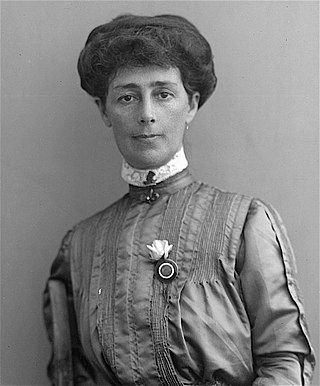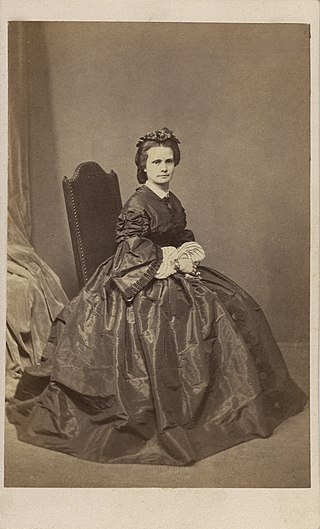Related Research Articles

Dame Millicent Garrett Fawcett was an English politician, writer and activist. She campaigned for women's suffrage by legal change and in 1897–1919 led Britain's largest women's rights association, the National Union of Women's Suffrage Societies (NUWSS), explaining, "I cannot say I became a suffragist. I always was one, from the time I was old enough to think at all about the principles of Representative Government." She tried to broaden women's chances of higher education, as a governor of Bedford College, London and co-founding Newnham College, Cambridge in 1875. In 2018, a century after the Representation of the People Act, she was the first woman honoured by a statue in Parliament Square.
The Woman's Christian Temperance Union (WCTU) is an international temperance organization. It was among the first organizations of women devoted to social reform with a program that "linked the religious and the secular through concerted and far-reaching reform strategies based on applied Christianity." It plays an influential role in the temperance movement. Originating among women in the United States Prohibition movement, the organization supported the 18th Amendment and was also influential in social reform issues that came to prominence in the progressive era.
Women's suffrage is the right of women to vote in elections. In the beginning of the 18th century, some people sought to change voting laws to allow women to vote. Liberal political parties would go on to grant women the right to vote, increasing the number of those parties' potential constituencies. National and international organizations formed to coordinate efforts towards women voting, especially the International Woman Suffrage Alliance.
First-wave feminism was a period of feminist activity and thought that occurred during the 19th and early 20th century throughout the Western world. It focused on legal issues, primarily on securing women's right to vote. The term is often used synonymously with the kind of feminism espoused by the liberal women's rights movement with roots in the first wave, with organizations such as the International Alliance of Women and its affiliates. This feminist movement still focuses on equality from a mainly legal perspective.

Vida Jane Mary Goldstein was an Australian suffragist and social reformer. She was one of four female candidates at the 1903 federal election, the first at which women were eligible to stand.

Henrietta Augusta Dugdale was a pioneer Australian who initiated the first female suffrage society in Australia. Non-conformist, provocative and quick-witted, her campaigning resulted in breakthroughs for women's rights in Australia.

Annie Lowe (1834–1910) was a suffragist in Victoria, Australia. She and Henrietta Dugdale founded the Victorian Women's Suffrage Society in 1884, the first organisation of this kind to be established in Australia.

Annette Bear-Crawford was a women's suffragist and federationist in Victoria.
The Australian Women's National League (AWNL) was an Australian political lobby group federation first established in 1904. It acted in many ways like a political party, with an extensive branch network and the capability to run its own candidates. It was a conservative organisation with four key declared objectives:
Government in Australia is elected by universal suffrage and Australian women participate in all levels of the government of the nation. In 1902, the newly formed Commonwealth of Australia became the first nation on earth to enact equal suffrage, enabling women to both vote and stand for election alongside men Women have been represented in Australian state parliaments since 1921, and in the Federal Parliament since 1943. The first female leader of an Australian State or Territory was elected in 1989, and the first female Prime Minister took office in 2010. In 2019 for the first time, a majority of members of the Australian Senate were women. At the time of its foundation in 1901, and again from 1952 to 2022, Australia has had a female monarch as ceremonial Head of State, while the first female Governor of an Australian State was appointed in 1991, and the first female Governor-General of Australia took office in 2008.

Women's suffrage in New Zealand was an important political issue in the late nineteenth century. In early colonial New Zealand, as in European societies, women were excluded from any involvement in politics. Public opinion began to change in the latter half of the nineteenth century and after years of effort by women's suffrage campaigners, led by Kate Sheppard, New Zealand became the first nation in the world in which all women had the right to vote in parliamentary elections.

A movement to fight for women's right to vote in the United Kingdom finally succeeded through acts of Parliament in 1918 and 1928. It became a national movement in the Victorian era. Women were not explicitly banned from voting in Great Britain until the Reform Act 1832 and the Municipal Corporations Act 1835. In 1872 the fight for women's suffrage became a national movement with the formation of the National Society for Women's Suffrage and later the more influential National Union of Women's Suffrage Societies (NUWSS). As well as in England, women's suffrage movements in Wales, Scotland and other parts of the United Kingdom gained momentum. The movements shifted sentiments in favour of woman suffrage by 1906. It was at this point that the militant campaign began with the formation of the Women's Social and Political Union (WSPU).

Women's suffrage in Australia was one of the early achievements of Australian democracy. Following the progressive establishment of male suffrage in the Australian colonies from the 1840s to the 1890s, an organised push for women's enfranchisement gathered momentum from the 1880s, and began to be legislated from the 1890s, decades in advance of Europe and North America. South Australian women achieved the right to vote in 1894, and to stand for office in 1895 following the world first Constitutional Amendment Act 1894. This preceded even male suffrage in Tasmania. Western Australia granted women the right to vote from 1899, although with some racial restrictions. In 1902, the newly established Australian Parliament passed the Commonwealth Franchise Act 1902, which set a uniform law enabling women to vote at federal elections and to stand for the federal parliament. By 1908, the remaining Australian states had legislated for women's suffrage for state elections. Grace Benny was elected as the first councillor in 1919, Edith Cowan the first state Parliamentarian in 1921, Dorothy Tangney the first Senator and Enid Lyons the first Member of the House of Representatives in 1943.

Una Harriet Ella Stratford Duval was a British suffragette and marriage reformer. Her refusal to say "and obey" in her marriage vows made national news. She bought the painting of Christabel Pankhurst by the suffragist Ethel Wright which was later donated to the National Portrait Gallery.
Eliza Pottie was an Australian social reformer, and a leader in women's organization in New South Wales. She was involved in the founding of the Young Women's Christian Association in Sydney, the Ladies' Sanitation Association, and the Women's Christian Temperance Union. She served as president of the Ladies Sanitation Association for nine years. She advocated for prison reform, supported orphanages, visited people in hospitals and institutions, and campaigned for women's suffrage. She was appointed to the Government Asylum Inquiry Board in 1886. A member of the Religious Society of Friends, she helped found the Quaker Relief Committee during the depression of 1893. In 1896, she attended the first National Council of Women New South Wales as a delegate for the WCTU. She died at her home in Manly in 1907.
Julia Rapke was an Australian, Jewish women's rights activist and Justice of the Peace, who held numerous roles in women's organisations regionally, nationally and internationally, including presidency of the Australian chapter of the Women's International Zionist Organization.

Maria (Marie) Elizabeth Kirk born Maria Elizabeth Sutton was a British born Australian temperance advocate and social reformer. She was involved in women's rights including organising a "monster" petition for women's suffrage in 1891.
References
- ↑ Melbourne, National Foundation for Australian Women and The University of. "The Victorian Women's Suffrage Society - Organisation - The Australian Women's Register". www.womenaustralia.info. Retrieved 2023-09-07.
- ↑ Hyslop, Anthea, "Kirk, Maria Elizabeth (1855–1928)", Australian Dictionary of Biography, Canberra: National Centre of Biography, Australian National University, retrieved 2023-09-07
- ↑ "Women in Parliament | Parliament of Victoria". new.parliament.vic.gov.au. Retrieved 2023-09-07.
- Australian Dictionary of Biography
- Jennifer S. Uglow, Maggy Hendry, The Northeastern dictionary of women's biography